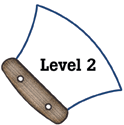|
National Science Education Standards
Heat can be produced in many ways, such as burning, rubbing, or mixing
one substance with another. Heat can move from one object to another by
conduction. (Page 127)
Heat moves in predictable ways, flowing from warmer objects to cooler
ones, until both reach the same temperature. (Page 155)
|
|
Benchmarks
Things that give off light also give off heat. Heat is produced by mechanical
and electrical machines, and any time one thing rubs against something
else. (Page 84)
When warmer things are put with cooler ones, the warm ones lose heat
and the cool ones gain it until they are at the same temperature. A warmer
object can warm a cooler one by contact or at a distance. (Page 84)
Some materials conduct heat much better than others. Poor conductors
can reduce heat loss. (Page 84)
|


